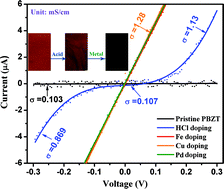Electrical conductivity manipulation and switching phenomena of poly(p-phenylenebenzobisthiazole) thin film by doping process
Abstract
Current–voltage (i-v) characteristics of dry poly(p-phenylenebenzobisthiazole) (

* Corresponding authors
a
Integrated Composites Laboratory (ICL), Dan F Smith Department of Chemical Engineering, Lamar University, Beaumont, TX, USA
E-mail:
zhanhu.guo@lamar.edu
Tel: (+1 409) 880-7654
b Department of Chemistry and Physics, Lamar University, Beaumont, TX, USA
c Electromagnetic Hardened Materials, Materials and Manufacturing Directorate, Air Force Research Laboratory, Wright-Patterson, AFB, OH, USA
Current–voltage (i-v) characteristics of dry poly(p-phenylenebenzobisthiazole) (

 Please wait while we load your content...
Something went wrong. Try again?
Please wait while we load your content...
Something went wrong. Try again?
J. Zhu, S. Wei, M. Alexander Jr., D. Cocke, T. C. Ho and Z. Guo, J. Mater. Chem., 2010, 20, 568 DOI: 10.1039/B917684E
To request permission to reproduce material from this article, please go to the Copyright Clearance Center request page.
If you are an author contributing to an RSC publication, you do not need to request permission provided correct acknowledgement is given.
If you are the author of this article, you do not need to request permission to reproduce figures and diagrams provided correct acknowledgement is given. If you want to reproduce the whole article in a third-party publication (excluding your thesis/dissertation for which permission is not required) please go to the Copyright Clearance Center request page.
Read more about how to correctly acknowledge RSC content.
 Fetching data from CrossRef.
Fetching data from CrossRef.
This may take some time to load.
Loading related content
